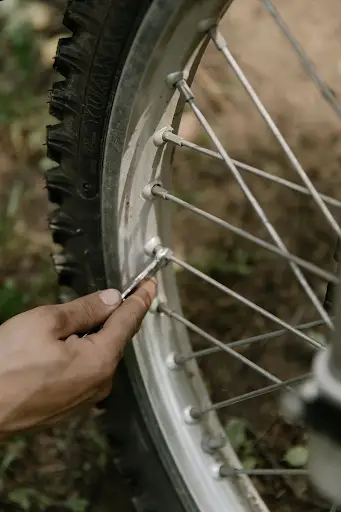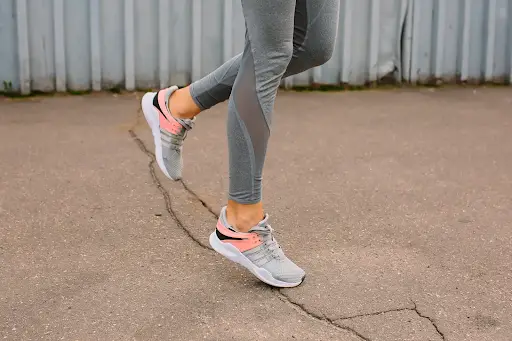Staying safe in a triathlon is something that can often be overlooked as people assume safety is common knowledge. This unfortunately is not the case and many people have lost their lives while participating.
This is why we feel it is an essential practice to remind ourselves and others of basic triathlon safety tips to avoid getting hurt. Learning how to stay safe in a triathlon is vital and although it may feel like you’re being told the obvious, we promise it’s worth listening to.
Whether you have been participating in triathlons for years or you are just beginning your journey, we have listed our top 10 triathlon safety tips below. We believe they will help keep you protected and push you to the finish line of success.
1. Be aware of surface hazards

Assessing surface hazards is crucial for staying safe in a triathlon, but it is the main safety area that participants tend to overlook. This is due to the expectation that event planners, hired helpers and volunteers have already made sure there are no active dangers on all routes.
While this is something that is done, it only eliminates big dangers such as moving large obstructions from the path. What cannot be done is sending out groups of people to fill each pothole or uneven surface with fresh tarmac.
This is where your initiative must come into play. You should actively be searching for obstacles that can come in your way during the cycling portion of a triathlon. This includes manhole covers, potholes, speed bumps and slippery surfaces (mud, water, gravel).
When encountering these surface hazards don’t panic, just go slower and assess your surroundings before you move around them so you don’t end up bumping into other participants.
2. Check your bikes condition

When you are training for a triathlon, you will hear multiple people tell you how important it is to check your bike’s condition. Triathlon safety tips such as this are key to ensuring a safe and successful experience.
Below we have bullet pointed a list so you can go through and check off each thing when you have completed it.
- Check your bike’s tire pressure using a floor pump multiple times in the days leading up to the race and on the morning of the race
- Ensure your bike’s seat is secure and will not come loose
- Make sure all components of the bike are running smoothly (wheels, chain)
- Check that your bike’s spokes are tight
- Make sure all additional pieces of gear are securely attached to the bike (Speed monitor, handlebar caps, gloves, water bottle)
- Test your brakes
- Ensure bike lights are attached and working properly
3. Wear a helmet
Hearing someone tell you that staying safe in a triathlon requires you to wear a helmet will no doubt have you rolling your eyes at them.
It is a known fact that you need to wear a helmet and all the reasons behind it. What is not often widely known is how to ensure your helmet is actually keeping you safe.
There are certain steps we encourage you to follow when choosing a helmet, this includes:
- Full coverage of your skull
- Secure straps attached to the helmet
- Make sure it is stable on your head and cannot come off during impact
- Ventilation sections are included to avoid overheating
- You can comfortably wear it with glasses if needed
- Made from durable material that will not be affected by sweat
4. Practice transitions
Triathlons are extremely demanding on your body which is why months of training are needed before participating. During training you may feel it makes sense to focus on running, swimming and cycling in individual increments to ensure you are ready for each component. .

Within our triathlon safety tips we believe it is super beneficial to practise your transition between each activity. This will give you the opportunity to build up your endurance and also perfect your changing routine so you can quickly and safely move on.
5. Pace yourself
Our fourth tip on how to stay safe in a triathlon ties nicely into our fifth. Repeating and perfecting your routine allows your body to adapt and adjust to the rigorous process.
Staying safe in a triathlon requires a lot of practice and developing a suitable pace for your body. It can be so easy to get carried away at the beginning of the swimming section with all the anxiety and excitement around you.
But if you set off at a faster pace than your body can handle, you will find yourself slowing down and ultimately putting yourself in a dangerous position as other participants try to move past you. We recommend reading things such as beginners guide to open water swimming so you can learn how to safely handle a situation like that.
6. Delayed swimming start
If this is your first time participating or you are just not the fastest swimmer, it may be worth using a delayed swimming start to ensure you are staying safe in a triathlon.
It will not majorly affect your timing and instead will help you feel more confident when you can stay at your own pace. This also allows you to avoid faster swimmers catching your body and face with their elbows as they make their way past you.
Within this realm of triathlon safety tips it is worth mentioning that you should learn and practise more than one swimming technique (Sidestroke, Backstroke, Breaststroke) so you can alternate to avoid becoming tired.
7. Wear broken in running shoes
A rule triathletes live by is to never try anything new on the day of the triathlon. It does not matter if you have just got brand new, super exclusive and amazing running shoes, do not use them over your old pair.

Learning how to stay safe in a triathlon means understanding that new isn’t always better. Your old shoes have trained for hours and months with you, they have moulded around your feet to offer the utmost comfort. Betraying them for a new pair will leave your feet sore and possibly put you in danger of things such as a sprained ankle.
8. Wear appropriate clothing
The clothes you wear on the day of a triathlon can easily make or break you. Below we have listed our triathlon safety tips when it comes to clothing:
- Wear light coloured clothing to avoid overheating
- Wear material that will has breathing holes for your sweat to exit from
- Easy shoes to take on and off (velcro, lace lock)
- Reflective elements on clothing so you can easily be seen
- Correctly sized helmet
- Swimming cap and wetsuit for the swimming portion
9. Take energy supplements
Similar to our advice about your shoes and how to stay safe in a triathlon, we also suggest that you don’t change up your supplement or energy drink routine before the big day. Always take what your body is used to to ensure a safe reaction.
10. Stay hydrated
Commonly after the completion of a triathlon, many participants require medical help for intense dehydration. One of the biggest triathlon safety tips we can provide to help you avoid damaging your body is to make sure you have plenty of fluids every hour.
You can take the most advantage of your water bottle during the cycling and running process as it is easy to multitask. Keeping the sprout of your bottle open allows this process to be faster and less likely to throw you off track.
During the swimming section you can indulge in energy or hydration gels before and after you get into the water to make up for the time in between. Hydration is needed by your body and shouldnt be neglected, even if this means slowing down and having some water.


